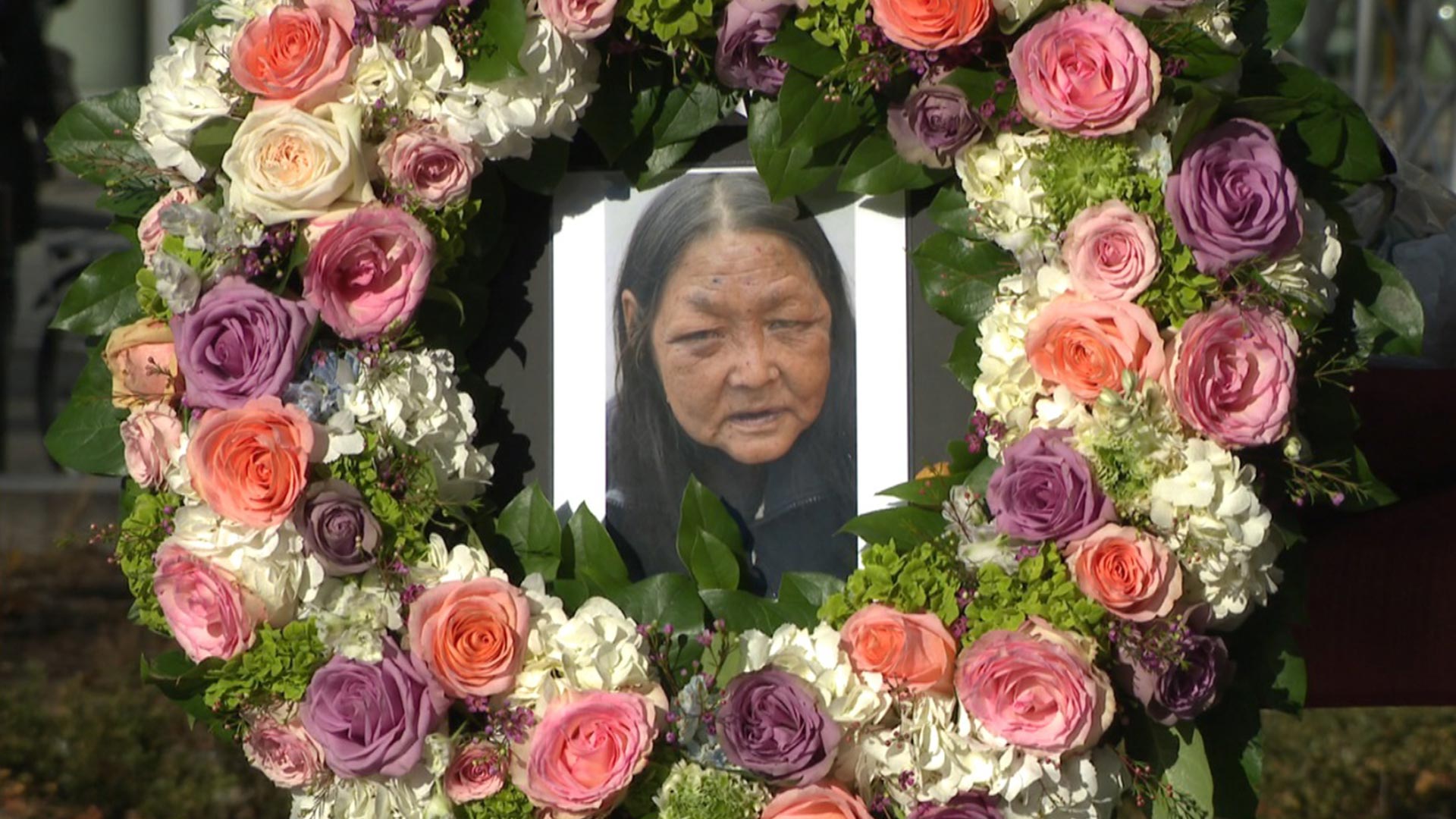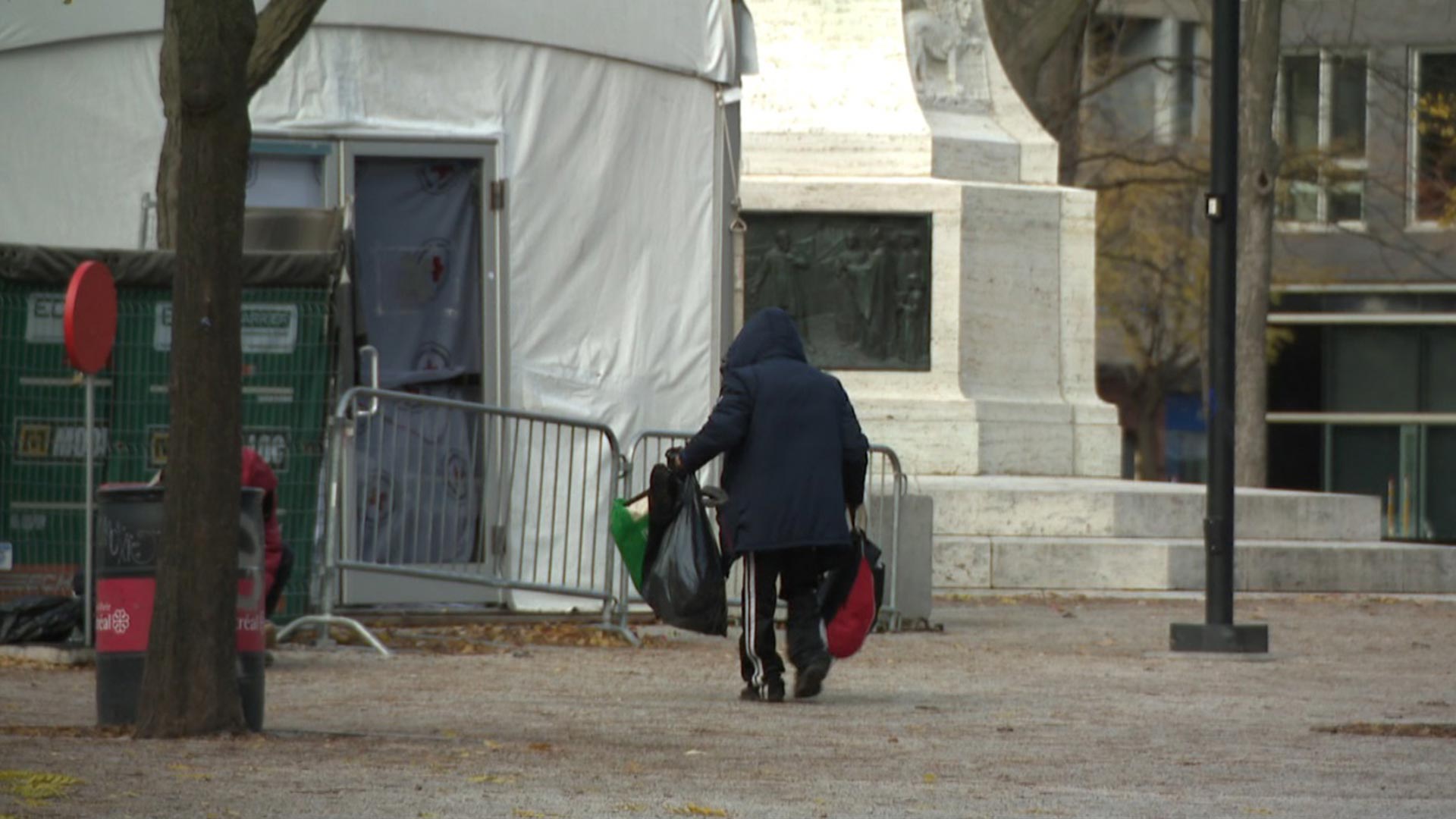Homeless advocates and supporters came out in droves to pay their respects to Elisapie Pootoogook, the 61-year-old Inuk whose body was discovered at a downtown Montreal construction site nearly two weeks ago.
They came with flowers, and with questions: how did Elisapie die? Are others in danger? Is there emergency funding available to better protect the homeless?
Speakers addressing the hundred-person crowd asked why the mayor of the city wasn’t there.
“I understand the mayor of Montreal was invited to attend this ceremony today. And she didn’t show,” said Assembly of First Nations Quebec-Labrador Regional Chief Ghislain Picard.
“I think the city needs to wake up and maybe look at this as an opportunity to provide an example to other cities across the country.”
“[Mayor] Valerie Plante, I was hoping to meet you here today, but I’m going to invite you to come and meet with us, so we can get a homeless policy – whether you’re white, green, black, Inuk, gold – so we can help our people,” added Rita Novalinga, a representative of the Makivik Corporation.
APTN News reached out to Mayor Valerie Plante’s office to find out why she allegedly did not respond to an invitation to the vigil.
In an email, a mayoral spokesperson said they conducted “several verifications with the city and the borough of Ville Marie,” but never received the above-mentioned invitation.
“From the moment she was informed of the facts, [Plante] and her team were devastated,” according to the email.
“Every death in these circumstances is one death too many. The City of Montreal is continuing to work hard to ensure that no one is left behind.”
In the same email, the spokesperson detailed the city’s plan to double its budget for the homeless – from $3 million to $6 million – over the next four years. It also detailed the city’s plan to invest in more social housing for the urban Indigenous population.
But in the wake of Elisapie’s death, those close to the cause say action is needed immediately.
“This weekend, I was walking around, and I saw homeless people everywhere. Like when you go into a bank, they’re sleeping on the floor. In metros. Everywhere,” explained Nakuset, executive director of the Native Women’s Shelter of Montreal. “There’s clearly a problem, I just don’t understand why the solution isn’t there.
“Why don’t they have something sustainable?”
Shelter workers say Elisapie was ‘caught between two worlds’

Elisapie Pootoogook reportedly spent her last days playing a game of “cat and mouse” with metro security agents near the downtown Montreal drop-in shelter she often frequented, according to those who knew her.
“This was known at least a few days before her death,” explained David Chapman, executive director of Resilience Montreal. “She’d be in the metro, she’d see the security coming and she’d come out into the park for a bit. The security would move on, so she’d go back into the metro – and that pattern would continue.
“Well, at one point it appears she went a little further than the park.”
Around 8:30 a.m. on Nov. 13, Montreal police were alerted to the discovery of a woman’s body near the construction site of a luxury condo complex across from Cabot Square, a well-known hub for the city’s urban Indigenous population.
The woman was later identified by shelter workers as Poogootook from Kinngait, formerly known as Cape Dorset in Nunavut.
A Montreal police spokesperson told APTN News they don’t suspect foul play, but the file has since been transferred to the Quebec coroner’s bureau for an autopsy to determine the exact cause of death.
“She had a real personality to her. I remember she’d use my phone often, and she would call her family members in the north,” Chapman explained.
“She would be singing lullabies to her grandkids on my phone while panhandling in the metro – and it was quite something.”
Though she had returned home to the North several times, Chapman says her situation was complicated by frequent travel south for medical treatment.
“In some ways, she was kind of caught between two worlds,” he said.
During the memorial held this week, Elisapie was remembered by members of the street community as a “loving” woman who made the best of her days in Montreal.
“It was hard. She was sick and it was hard as hell – but she survived. And we have to live this way,” explained Elisapie’s niece.
“She taught me how to live. And I lived with her. And I loved her very much, my beautiful aunt.”
“I want to thank her for everything – for her kindness,” added another woman named Carol.
“She always treated everyone equally. No differences.”
However, homeless advocates see discrepancies in the government response to issues involving Montreal’s homeless Indigenous population.
“Why is it always our responsibility? Why doesn’t the city and the province and the Feds come together and say ‘this is our solution?’” Nakuset said. “People should be outraged that in one year, we’ve had two people who have now passed on.”
“It’s a city of reconciliation, but we have two Indigenous people that are very vulnerable and have passed away.”
Community-run warming tent at risk of closure

Resources for the homeless in Montreal are affected on an ongoing basis by the COVID-19 pandemic – though they received a much-needed push after another fatal incident earlier this year.
Raphael “Napa” Andre, an Innu-Naskapi man from Matimekush Lac-John in northern Quebec, was found dead in a portable toilet in the Milton-Parc neighbourhood near the shelter he frequented back in January 2021.
Andre’s death caused a wave of indignation and community-based action and eventually resulted in the opening of the “Raphael Andre Memorial tent,” a warming space in Cabot Square.
But the warming tent, according to Chapman, can only house up to 15 people at a time. And without sustained funding, it’s likely to close in the first week of December.
Up until now, the shelter’s operating bill has been footed by benefactors from the Mohawk and Innu Nation.
“The Innu Nation is paying like $6,000 a week for food – we’re really going above and beyond,” Nakuset explained. “I need to raise about $650,000 by the end of the week, otherwise they’re going to shut [the tent] down. And if they shut the tent down, what are they going to do with the overflow?”
“It keeps me up at night to find that money.”
Read More:
In their email to APTN, a City of Montreal spokesperson said they’re “currently discussing the terms of the continuation of the [warming tent] project” with the Quebec government and are prepared to continue allocating money for the physical tent space.
They’re also assessing “alternatives and more sustainable solutions for the future,” according to the email.
But Nakuset says a permanent, Indigenous-led night shelter is gravely needed.
“There is no safe space to go in this area, which is why – in this area – [Elisapie] wasn’t able to find something warm,” she said.
“This an ongoing problem, and it’s also a somewhat unnecessary problem. Especially when governments have the power to create safer places for people to be,” Chapman added.
“If it’s cold, you can only get away with [wandering] for so long. And in this case, it looks like [Elisapie] didn’t get away with it.”









